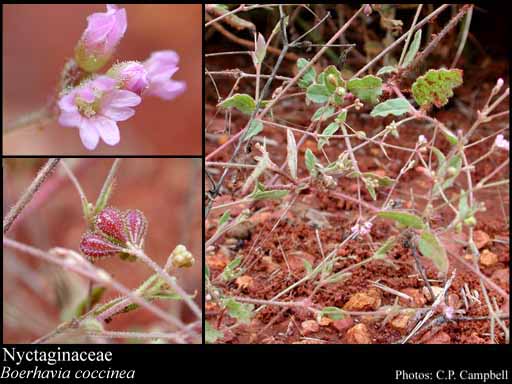- Reference
- Gen.Pl. [Jussieu] 90 (1789)
- Name Status
- Current

Scientific Description
Common name. Four o'clock Family.
Habit and leaf form. Trees, shrubs, and herbs, or lianas (occasionally, in Pisonia). Self supporting (mostly), or climbing (occasionally). Mesophytic. Leaves alternate (sometimes), or opposite (usually, members of the pair often unequal); petiolate to sessile; non-sheathing; simple. Leaf blades entire; pinnately veined; cross-venulate. Leaves without stipules. Stem anatomy. Nodes unilacunar. Secondary thickening mostly anomalous; mostly via concentric cambia.
Reproductive type, pollination. Fertile flowers hermaphrodite, or functionally male and functionally female, or hermaphrodite and functionally female, or hermaphrodite, functionally male, and functionally female. Unisexual flowers present, or absent. Plants hermaphrodite (usually), or monoecious, or andromonoecious, or gynomonoecious, or polygamomonoecious.
Inflorescence and flower features. Flowers solitary, or aggregated in ‘inflorescences’; in cymes, in panicles, in spikes, and in umbels. The terminal inflorescence unit usually cymose. Inflorescences terminal, or axillary; with involucral bracts (frequently, these often brightly coloured), or without involucral bracts; pseudanthial (sometimes, especially when reduced to a single flower — the involucre then calyx-like, the calyx corolla-like), or not pseudanthial. Flowers bracteate (usually with several bracts); small, or medium-sized; regular; usually cyclic; tricyclic. Free hypanthium absent. Hypogynous disk often present (around G); annular. Perianth sepaline, or petaline (ostensibly, but even then generally regarded as representing ‘petaloid sepals’); (3–)5(–10); 1 -whorled; joined. Calyx (i.e. the perianth) (3–)5(–10); 1 -whorled; gamosepalous; valvate, or plicate in bud; campanulate, or urceolate (rarely), or funnel-shaped, or tubular; regular; base persistent (and usually remaining around the fruit). Fertile stamens present, or absent (female flowers). Androecium (1–)5(–30). Androecial sequence determinable, or not determinable. Androecial members when numerous, maturing centrifugally; adnate (to the perianth tube, occasionally), or free of the perianth (usually); all equal, or markedly unequal; free of one another, or coherent; when coherent, 1 - adelphous (the filaments basally connate); 1 -whorled. Androecium exclusively of fertile stamens. Stamens (1–)5(–30); typically alternisepalous; inflexed in bud. Anthers dehiscing via longitudinal slits; introrse; tetrasporangiate. Fertile gynoecium present, or absent (male flowers). Gynoecium 1 carpelled. The pistil 1 celled. Carpels reduced in number relative to the perianth. Gynoecium monomerous; of one carpel; superior. Carpel stylate; apically stigmatic, or with a lateral style; 1 ovuled. Placentation basal. Stigmas dry type; papillate; Group II type. Ovules ascending; non-arillate; campylotropous, or hemianatropous.
Fruit and seed features. Fruit non-fleshy. The fruiting carpel indehiscent; an achene, or nucular. Fruit usually enclosed in the persistent base of the perianth; 1 seeded. Seeds endospermic (the endosperm forming a cap over the radicle), or non-endospermic. Perisperm present. Seeds with starch. Embryo well differentiated (large). Cotyledons 2. Embryo chlorophyllous (2/2); curved (usually), or straight, or bent. Seedling. Germination phanerocotylar.
Physiology, biochemistry. Plants often accumulating free oxalates. Photosynthetic pathway: C3 and C4.
Geography, cytology, number of species. World distribution: pantropical and subtropical. X = 10, 13, 17, 29, 33 (or more). 290 species.
Economic uses, etc. A few popular ornamentals, e.g. the annual Mirabilis and the subtropical vine Bougainvillea.